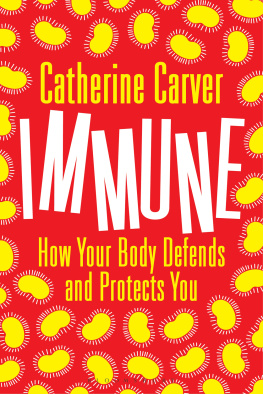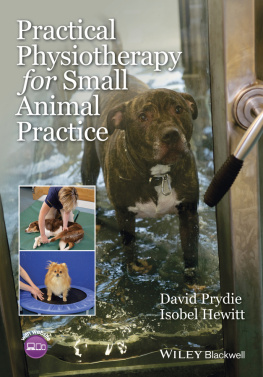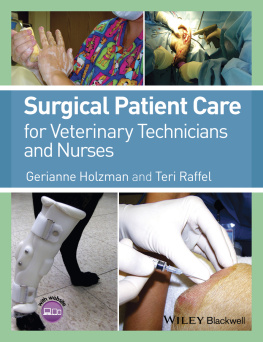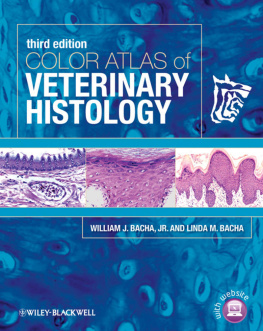Carver - Practical Physiotherapy for Veterinary Nurses
Here you can read online Carver - Practical Physiotherapy for Veterinary Nurses full text of the book (entire story) in english for free. Download pdf and epub, get meaning, cover and reviews about this ebook. City: Chichester;West Sussex, year: 2016;2015, publisher: John Wiley & Sons, Incorporated;Wiley Blackwell, genre: Children. Description of the work, (preface) as well as reviews are available. Best literature library LitArk.com created for fans of good reading and offers a wide selection of genres:
Romance novel
Science fiction
Adventure
Detective
Science
History
Home and family
Prose
Art
Politics
Computer
Non-fiction
Religion
Business
Children
Humor
Choose a favorite category and find really read worthwhile books. Enjoy immersion in the world of imagination, feel the emotions of the characters or learn something new for yourself, make an fascinating discovery.

Practical Physiotherapy for Veterinary Nurses: summary, description and annotation
We offer to read an annotation, description, summary or preface (depends on what the author of the book "Practical Physiotherapy for Veterinary Nurses" wrote himself). If you haven't found the necessary information about the book — write in the comments, we will try to find it.
Practical Physiotherapy for Veterinary Nurses — read online for free the complete book (whole text) full work
Below is the text of the book, divided by pages. System saving the place of the last page read, allows you to conveniently read the book "Practical Physiotherapy for Veterinary Nurses" online for free, without having to search again every time where you left off. Put a bookmark, and you can go to the page where you finished reading at any time.
Font size:
Interval:
Bookmark:
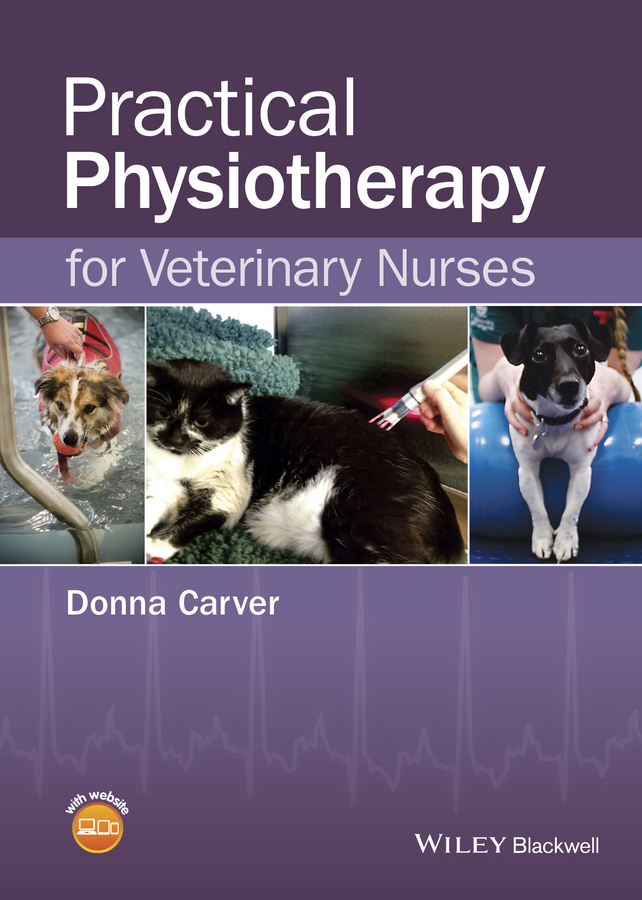
- Chapter 01
- Chapter 02
- Chapter 03
- Chapter 04
- Chapter 01
- Chapter 02
- Chapter 03
- Chapter 04
Donna Carver BSc (Hons) Physiotherapy
Dip AVN (surg), RVN, MCSP
Chartered Physiotherapist, Specialist Veterinary Nurse
School of Veterinary Medicine
University of Glasgow, UK

This edition first published 2016 2016 by John Wiley & Sons, Ltd.
Registered Office
John Wiley & Sons, Ltd, The Atrium, Southern Gate, Chichester, West Sussex, PO19 8SQ, UK
Editorial Offices
9600 Garsington Road, Oxford, OX4 2DQ, UK
The Atrium, Southern Gate, Chichester, West Sussex, PO19 8SQ, UK
1606 Golden Aspen Drive, Suites 103 and 104, Ames, Iowa 50010, USA
For details of our global editorial offices, for customer services and for information about how to apply for permission to reuse the copyright material in this book please see our website at www.wiley.com/wiley-blackwell
The right of the author to be identified as the author of this work has been asserted in accordance with the UK Copyright, Designs and Patents Act 1988.
All rights reserved. No part of this publication may be reproduced, stored in a retrieval system, or transmitted, in any form or by any means, electronic, mechanical, photocopying, recording or otherwise, except as permitted by the UK Copyright, Designs and Patents Act 1988, without the prior permission of the publisher.
Designations used by companies to distinguish their products are often claimed as trademarks. All brand names and product names used in this book are trade names, service marks, trademarks or registered trademarks of their respective owners. The publisher is not associated with any product or vendor mentioned in this book. It is sold on the understanding that the publisher is not engaged in rendering professional services. If professional advice or other expert assistance is required, the services of a competent professional should be sought.
The contents of this work are intended to further general scientific research, understanding, and discussion only and are not intended and should not be relied upon as recommending or promoting a specific method, diagnosis, or treatment by health science practitioners for any particular patient. The publisher and the author make no representations or warranties with respect to the accuracy or completeness of the contents of this work and specifically disclaim all warranties, including without limitation any implied warranties of fitness for a particular purpose. In view of ongoing research, equipment modifications, changes in governmental regulations, and the constant flow of information relating to the use of medicines, equipment, and devices, the reader is urged to review and evaluate the information provided in the package insert or instructions for each medicine, equipment, or device for, among other things, any changes in the instructions or indication of usage and for added warnings and precautions. Readers should consult with a specialist where appropriate. The fact that an organization or Website is referred to in this work as a citation and/or a potential source of further information does not mean that the author or the publisher endorses the information the organization or Website may provide or recommendations it may make. Further, readers should be aware that Internet Websites listed in this work may have changed or disappeared between when this work was written and when it is read. No warranty may be created or extended by any promotional statements for this work. Neither the publisher nor the author shall be liable for any damages arising herefrom.
Library of Congress Cataloging-in-Publication Data
Carver, Donna, 1968 , author.
Practical physiotherapy for veterinary nurses / Donna Carver.
p. ; cm.
Includes bibliographical references and index.
ISBN 978-1-118-71136-1 (paper)
I. Title.
[DNLM: 1. Physical Therapy Modalitiesnursing. 2. Physical Therapy Modalitiesveterinary. 3. Hydrotherapyveterinary. 4. Physical Examinationveterinary. 5. Veterinary Medicinemethods. SF 925]
SF925.C37 2016
636.0895853dc23
2015015321
A catalogue record for this book is available from the British Library.
Wiley also publishes its books in a variety of electronic formats. Some content that appears in print may not be available in electronic books.
I would like to dedicate this book to the patients and clients I have worked with throughout my career.
I would also like to thank the staff at the University of Glasgow Veterinary School for their support and for helping me make this book possible, with special thanks to Clare Skea (RVN) for her photography skills and patience.
Practical Physiotherapy for Veterinary Nurses is accompanied by a companion website:
www.wiley.com/go/carver/physiotherapy-veterinary-nurses
The website includes:
- Videos showing examples of exercises and treatments
- Self-assessment questions and answers taken from the book are offered in interactive form on the companion website to make testing yourself easier
Musculoskeletal physiotherapy
Gait analysis or assessment is a skill that requires close observation of the patient at walk and trot, to determine the cause and location of the lameness. A start point is to become familiar with a normal gait pattern, taking into account breed variations (i.e. dachshund vs bull mastiff). Once you are familiar with normal gait pattern, any deviation from this can be recognised.
Animals should be on a loose lead at walk and trot to observe for anatomical symmetry (normal gait pattern). Animals should be observed in a straight line towards, and then a straight line away from the observer. Pay particular attention to how the animal turns to both the left and right side this may show reluctance to transfer weight onto the affected limb, or that the animal has issues with balance. The observer should then view the animal moving from both left and right sides. Subtle lameness may not readily be observed at walking pace; however, at trot the animal will only have one thoracic limb and one pelvic limb in contact with the ground, and these limbs will be placed under greater pressure meaning a lameness may be easier to detect.
Videoing the gait pattern, then slowing it down on playback, may be a useful way to detect lameness.
Observe muscle symmetry, weight-bearing (paw and toe position) and conformation at rest.
Observe gait in a quiet area at walk and trot; thoracic limb lameness is often associated with head bobbing. When the animal takes its bodyweight through the painful thoracic limb the head will bob upwards in an attempt to unload the ground reaction force passing through the limb.
Pelvic limb lameness can be observed by a hiking up in the gluteal region in an attempt to offload or shift weight from the painful limb; this may be towards the contralateral pelvic limb, or forwards usually towards the contralateral thoracic limb. Lameness in pelvic limbs may also present with a
Next pageFont size:
Interval:
Bookmark:
Similar books «Practical Physiotherapy for Veterinary Nurses»
Look at similar books to Practical Physiotherapy for Veterinary Nurses. We have selected literature similar in name and meaning in the hope of providing readers with more options to find new, interesting, not yet read works.
Discussion, reviews of the book Practical Physiotherapy for Veterinary Nurses and just readers' own opinions. Leave your comments, write what you think about the work, its meaning or the main characters. Specify what exactly you liked and what you didn't like, and why you think so.

